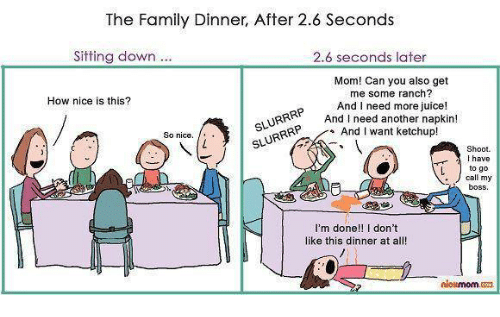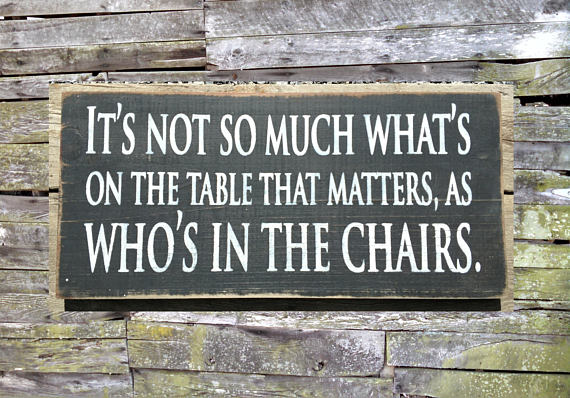It was hard to gather my children to the table when they were younger. Getting dinner timed just right and to the table was frustrating. Eventually, we’d sit down and invariably someone didn’t like what was being served. Ten minutes later (less time than it took to prepare the meal), the hurricane would leave. Some nights I wondered if I was doing something wrong and if it was even worth it, though instinctively I knew eating together was important.



Fast forward to the present day and my older children who have left home return, almost on a weekly basis, to not only eat dinner, but to linger at the table for fun family conversation. This is why it was so important to build those patterns early.
Meme from: https://imgflip.com/i/18fwa8
Did you know that 79% of adolescents actually enjoy eating dinner with their families? And that despite how drawn they might be to “Riverdale” or “Pretty Little Liars,” eating family dinner ranks higher than watching TV, and that teens enjoy dinnertime as much as going on vacation (see below for reference).
If dinner is such a highly ranked activity, why is it on the decline? Family dinner can be a great protection to our children, but it has fallen to the bottom of our priority list. In today’s modern world, convenience is our mantra and busy is our lifestyle. Mom and dad both come home from work picking up their children and dry cleaning on the way. Many homes are headed by a single parent, and if there are two parents, odds are high that both of them work. In addition, parents and children are overscheduled and what little free time they do have, often conflicts, not allowing time for families to find a common dinnertime.
Family mealtime is simply not the typical pattern in many homes. When we first moved into our current area and my children made friends, one of my daughters would frequently invite her best friend to stay and eat with us. This friend told me that at first, she thought it was weird that we ate dinner together almost every night, but that she grew to enjoy and appreciate the regular sit-down time and conversation.
If dinner is such a highly ranked activity, why is it on the decline? Family dinner can be a great protection to our children, but it has fallen to the bottom of our priority list. In today’s modern world, convenience is our mantra and busy is our lifestyle. Mom and dad both come home from work picking up their children and dry cleaning on the way. Many homes are headed by a single parent, and if there are two parents, odds are high that both of them work. In addition, parents and children are overscheduled and what little free time they do have, often conflicts, not allowing time for families to find a common dinnertime.
Family mealtime is simply not the typical pattern in many homes. When we first moved into our current area and my children made friends, one of my daughters would frequently invite her best friend to stay and eat with us. This friend told me that at first, she thought it was weird that we ate dinner together almost every night, but that she grew to enjoy and appreciate the regular sit-down time and conversation.
So what can busy families do to make family mealtime a reality?
First, Get Creative!
It’s going to take some creative out-of-the-box thinking to overcome some of the roadblocks to eating a family meal together. Do you need to assign different cooks for different nights? Have you tried once-a-month cooking? One family couldn’t make family dinner work because the six of them were scattered every evening. To make family time happen, they would eat breakfast together every morning because it was the one time of day they were all guaranteed to be in the house at the same time.
Second, Make it a priority!
Oprah Winfrey hosted a “Family Dinner Challenge.” In the challenge, families contracted to eat dinner together every night for a month, staying at the table together for at least 30 minutes. At first, the families thought that 30 minutes felt like an eternity. After a month, their perspective of this was very different. They determined that the time together was so valuable that, even though the challenge was over, would continue to eat together each night. The children of these families reported that they enjoyed and counted on this time with their parents at the dinner table.
Above all, remember:
Fruh, S. M., Fulkerson, J. A., Mulekar, M. S., Kendrick, L. J., & Clanton, C. (2011). Continuing
education: The surprising benefits of the family meal. The journal for nurse practitioners,
718-22. doi:10.1016/j.nurpra.2010.04.017

